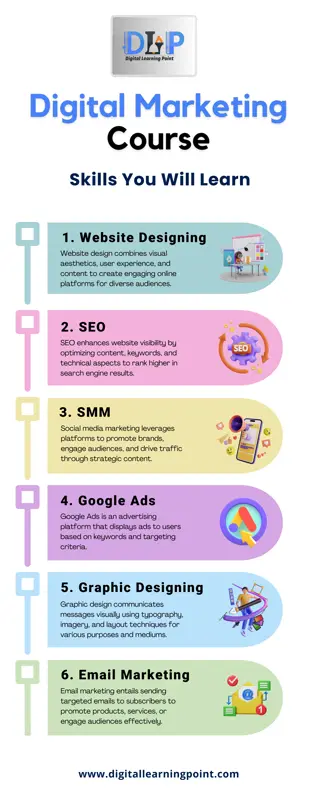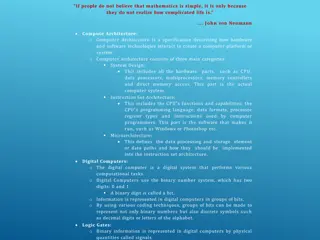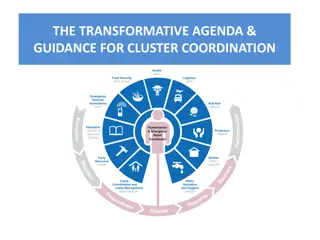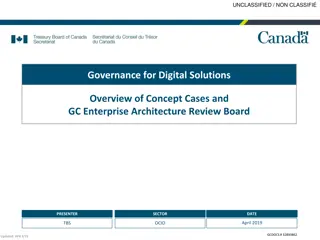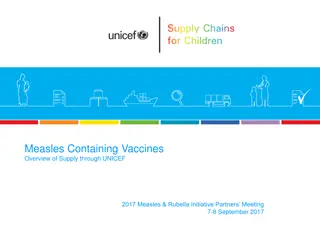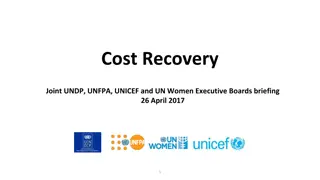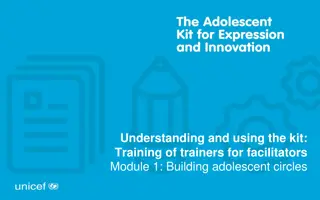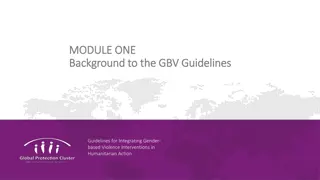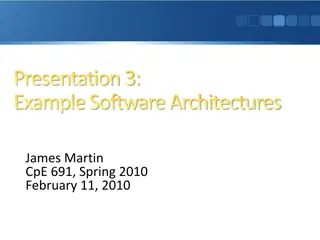Digital Architecture for Supporting UNICEF's High-Impact Interventions
In an ideal scenario, the digital architecture for children would encompass systems such as Enterprise Architecture, Functional Architecture, and Solution Architecture to support UNICEF's high-impact interventions. It would involve integrated platforms for Health Information Exchange, Supply Chain Management, Civil Registration, and more, operationalized through software products. The functional architecture would facilitate a wide array of functionality using re-usable Lego block transactions and interoperable point-of-service solutions. A glossary of key terminologies like client registry and supply chain management is provided for clarity.
- Digital Architecture
- UNICEF
- High-Impact Interventions
- Enterprise Architecture
- Functional Architecture
Download Presentation

Please find below an Image/Link to download the presentation.
The content on the website is provided AS IS for your information and personal use only. It may not be sold, licensed, or shared on other websites without obtaining consent from the author. Download presentation by click this link. If you encounter any issues during the download, it is possible that the publisher has removed the file from their server.
E N D
Presentation Transcript
Digital Architecture for Children In an ideal scenario, what systems would we have to support UNICEF s high-impact interventions?
3 architectures Enterprise architecture What pervasive digital infrastructure do we need so that our system will act like a system? Functional architecture What things to do we need to do; what workflows do we need to support? Solution architecture What software products will operationalize these workflows within the context of the enterprise infrastructure? 2
Enterprise Architecture Integrated platform supporting: Health Information Exchange (HIE) Health Insurance Management Information System (HIMIS) Civil Registration and Vital Statistics (CRVS) Supply Chain Management (SCM) including Distribution Requirements Planning (DRP) Shared ID registries for cardinal data assets (e.g. clients, facilities, providers, procedures, commodities, etc.) Seamless transaction processing across sub-systems; support for whole-system data analytics 3
Organizations Beneficiaries Billing Codes Transactions Empaneled Empaneled Insurance Insurance Providers Analytics Social Insurance in support of Universal Health Coverage Supply Chain Management including DRP Civil Registration and Vital Statistics ICP Engine eGov Interoperability Layer $ AB C SCM School Registrar Insurance 4
Glossary TS terminology service CR client registry SHR shared health repository HMIS health management information system FR facility registry HWR health worker registry ICP Engine integrated care pathway (guideline-based workflow) logic engine ILR interlinked registry (organization|facility|health worker|service) SCM supply chain management DRP distribution requirements planning 5
Functional Architecture From a couple of dozen Lego block transactions, a wide array of functionality can be supported The transactions are re-usable across public health and curative care workflows and will be operationalized by the shared digital infrastructure Point-of-service solutions will adhere to interoperability patterns that leverage the shared infrastructure s transactions 6
Functional Architecture Create a new client (demographic) record Update a client record Query for and retrieve a client record Query for and retrieve clinical information about a client Save clinical information about a client Order medications Dispense medications Order lab tests Receive lab results Refer a client (escalate care) Discharge a client Query for providers, facilities, organizations or services Execute care guideline logic Send alerts or reminders to providers or to clients Aggregate person-centric transactions to generate reportable indicators (HMIS) 1. 8. 9. 2. 10. 3. 11. 12. 4. 13. 5. 14. 6. 15. 7. 7
Functional Architecture Share client demographic data with the CRVS system Establish a client s health insurance status Transact the payment of health insurance premiums Record the provision of insured services Pay for the provision of insured services Record (or imply) inventory consumption transactions Calculate perpetual inventory levels Record inventory physical counts Develop inventory replenishment plans (DRP) Transact supply chain logistics: requisition, order, pick, pack, ship, receive, return, scrap 16. 21. 17. 22. 18. 23. 19. 24. 20. 25. 8
Particularly useful functionality New client demographic records for newborns will automatically be shared with the CRVS system Insurance status will be managed as an attribute of the client demographic record; authenticating the ID of the client will automatically indicate the available insured services Posting care delivery transactions to the shared health record (SHR) will automatically create the associated health insurance claim transactions Recording certain care delivery transactions (e.g. medication dispense) will automatically create inventory consumption transactions Tick-of-the-clock events can generate guideline-based alerts (e.g. vaccination visit reminders, alerts for missed vaccination visits, etc.) 9
Solution Architecture Point-of-service digital solutions will be able to transact with the shared digital infrastructure s interoperability layer The transaction processing pattern will resolve local IDs to enterprise IDs Information sharing, based on enterprise IDs, will support continuity of guideline-based care over time and across different sites Paper-based systems will asynchronously update electronic systems via manual data entry and/or the scanning of engineered paper forms 10
Example: Immunization Registry Solution profile: Create, update, query/retrieve child demographic records (functions: 1, 2, 3) Retrieve the child s present immunization status; based on this status, calculate what vaccines are to be administered (4, 13) Record weight and, if stock is available, administer vaccines (5, 7) Based on aggregated vaccine administrations, generate HMIS indicators (15) and deplete inventory (21) Based on the child s last visit date and vaccine schedule, send SMS visit reminders to child s mum, or health worker, or both (3, 12, 14) Manage vaccine stores (22, 23, 24, 25) 11
Solution Architecture This is ONE example use case (childhood immunization) There are many more examples The patterns are highly re-usable across other use cases and across different software solution platforms (e.g. web, mobile, engineered paper) 18
Summary The architecture needed for children isn t different than the architecture needed for everyone A relatively small set of functional Lego blocks is needed to serve a wide array of use cases Point-of-service (POS) solutions will plug into the data sharing infrastructure so that care continuity and coordination can happen 19







